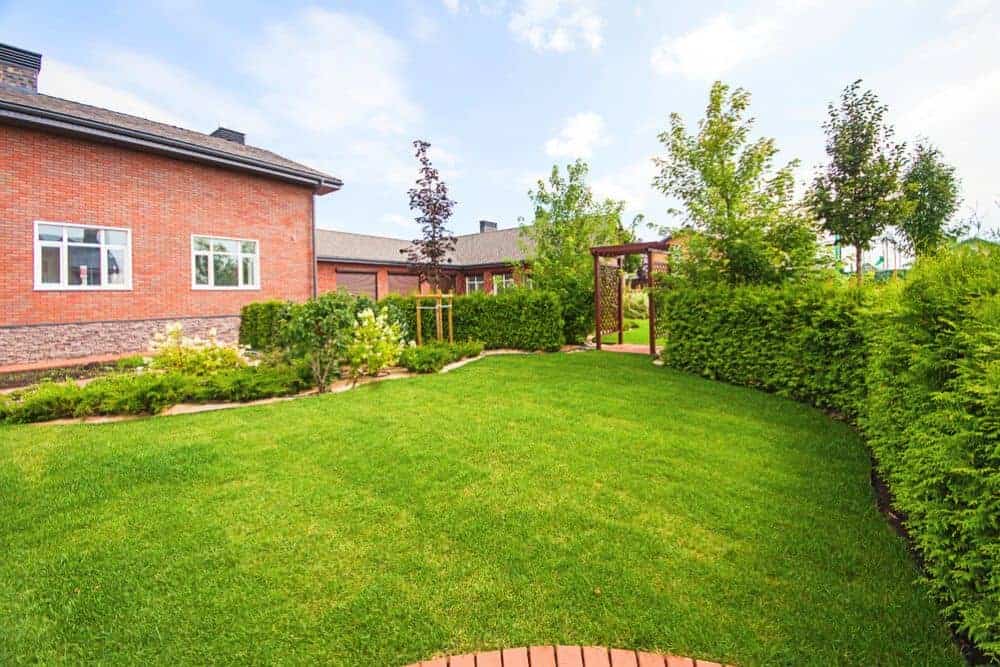Thinking of laying a new lawn? Whether you’re starting from scratch or replacing patchy turf, choosing the right grass matters.
If your turf isn’t suited to your local climate, your lawn can thin out or turn brown in places.
The soil type, sunlight, and level of foot traffic also affect how well your grass will grow.
Luckily, there are many turf types available. Some thrive in shade, some recover fast from wear, and others need less water.
Below, we’ll talk about the different types of lawn grass in Australia, so you can find one that fits your needs!
Lawn Grasses in Australia | Warm-Season Grasses | Cool-Season Grasses | Lawn Care Tips
What to Consider When Choosing Your Lawn Grass
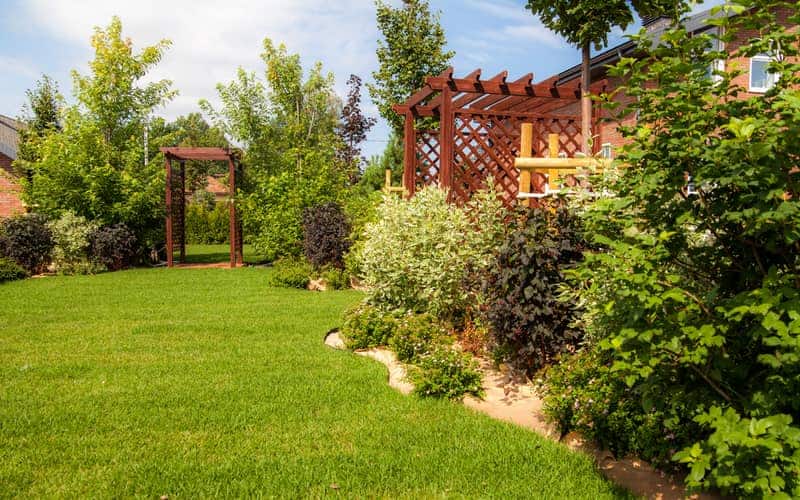
Before choosing grass for your lawn, take a look at your local conditions and how you plan to use the space.
CLIMATE: Warm-season grasses thrive in hotter parts of Australia, while cool-season types suit cooler areas.
SUNLIGHT: Some varieties grow best in full sun, while others can tolerate some shade.
SOIL: Check if the grass is suited to your soil type and pH level. If not, amend it before laying turf.
WATER NEEDS: Drought-tolerant grasses are ideal for dry areas or waterwise gardens.
FOOT TRAFFIC: If you have kids or pets, pick a grass that can recover fast.
LAWN CARE: Different grasses grow at different rates, which affects how often you need to mow your lawn!
LOOK AND FEEL: Some lawns grow dense and thick, while others have a finer appearance.
Common Lawn Grass Types in Australia
The chart below lists the different grass types in Australia and their key features.
| WARM-SEASON GRASSES | |
|---|---|
| Buffalo | Shade-tolerant, soft underfoot, easy upkeep |
| Couch | Drought-tolerant, fine texture, self-repairs quickly |
| Kikuyu | Vigorous grower, ideal for very high-traffic areas |
| Zoysia | Slow-growing, very low maintenance, suited to coastal areas |
| COOL-SEASON GRASSES | |
| Kentucky Bluegrass | Dense, self-repairing, often blended with other grasses |
| Tall Fescue | Top choice for colder regions, drought-tolerant, coarse leaf blades |
| Perennial Ryegrass | Quick to establish, commonly used for overseeding |
Still unsure which one to go for? We’ll talk about each type below to help you decide.
TIP: If you’re after something truly Australian, there are plenty of native grasses that can create a beautiful lawn!
Warm-Season Grasses in Australia
Warm-season varieties grow best in a temperature range of 25°C–35°C.
They love hot summers and mild winters, making them well-suited to much of Australia.
They’re also tough, as they can handle drought and poor soils.
Buffalo grass
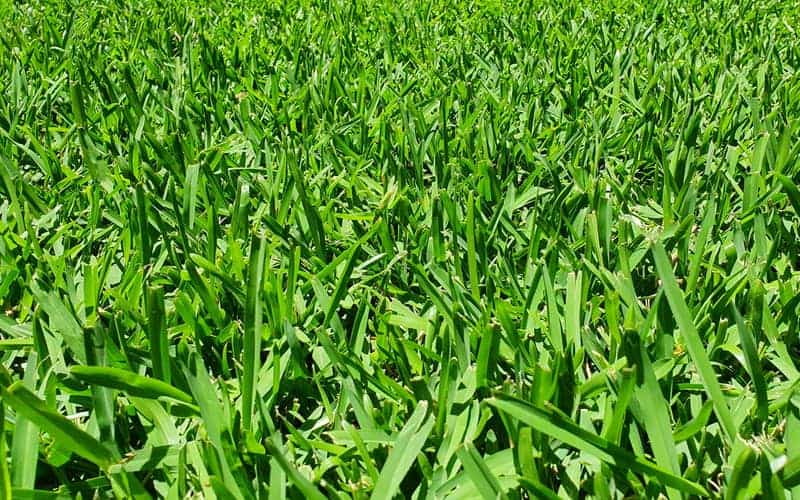
Growing conditions: Any well-draining soil; full sun to partial shade
Watering: Infrequent, deep watering
Mowing: Fortnightly in warmer months
Buffalo is one of the most popular turf grasses in Australia — a great choice for family-friendly or informal spaces!
Since Buffalo has a creeping habit, it quickly grows back in worn or patchy spots.
It’s also quite low-maintenance. Regular mowing every fortnight is usually enough to keep it neat.
Moreover, Buffalo lawns can tolerate drought conditions, so they’re perfect for waterwise gardens.
As for appearance, Buffalo grass is known for its broad, deep green leaf blades, around 7mm across.
While older types can be scratchy, modern soft-leaf Buffalo grass varieties are gentler to touch and walk on.
Popular soft-leaf varieties include:
- Sapphire: Known as the softest buffalo variety
- Sir Walter: Handles shade and drought very well
- Palmetto: Highly drought-tolerant; resists pests and weeds
- Prestige: Has very dark green leaves; excellent wear resistance
Couch grass
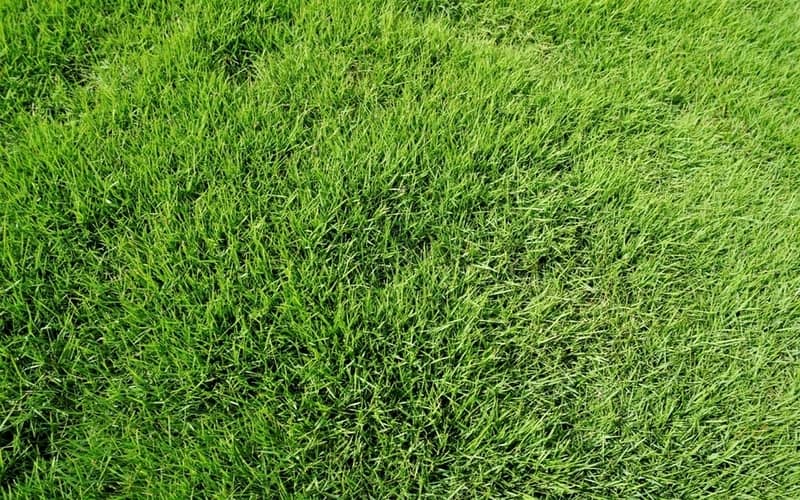
Growing conditions: Any well-drained soil; full sun
Watering: Infrequent, deep watering
Mowing: Every 5–7 days
In Australia, Couch grass — also called Bermuda — is a favourite for home lawns!
Couch has fine leaf blades (around 4mm wide) that give lawns a lush, soft look.
Moreover, it handles foot traffic well and can repair bare patches on its own. That’s why it’s often used in home gardens, golf courses, and sports fields.
Couch grass is also highly drought-tolerant. It survives with little water and can recover after long dry spells.
The downside is that Couch grows aggressively. To keep it under control, you’ll need to mow it regularly, ideally every 5–7 days.
Also, keep in mind that Couch grass is sensitive to waterlogging. If your soil retains too much moisture, consider aerating the lawn first.
There are multiple types to choose from if you want a Couch lawn:
- Oztuff: Australian-bred; tough and drought-tolerant
- Wintergreen: Stays green in winter; widely used in QLD
- Stadium Sports: High wear tolerance; bred for sports use
- TifTuf: Benchmark for drought tolerance in Australia and globally
Kikuyu grass
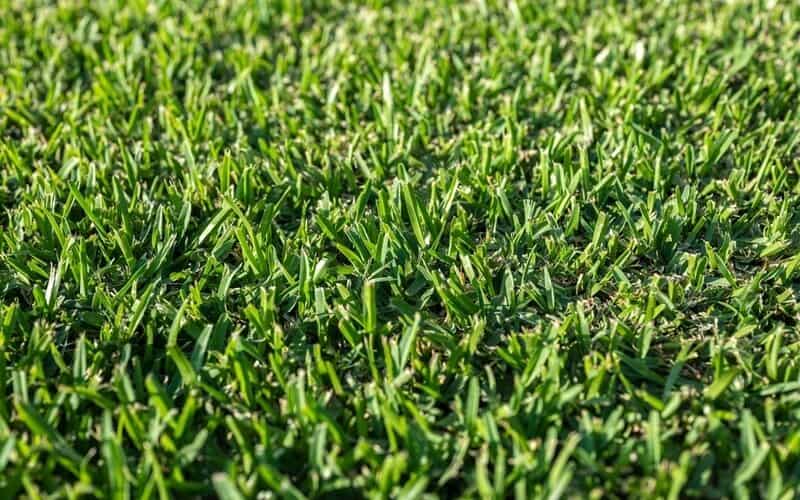
Growing conditions: Well-drained soil; full sun
Watering: Infrequent, deep watering
Mowing: At least once a week in warmer months
If you have kids or pets or love hosting backyard gatherings, a Kikuyu lawn is suitable.
However, Kikuyu is considered an environmental weed in some states. Be sure to check local regulations first before planting!
Kikuyu grass has a slightly coarse texture and pointed leaf blades that are about 4–7mm wide.
It’s often used in high-traffic areas (even for sports fields!), as it spreads quickly and bounces back fast when damaged.
Keep in mind that Kikuyu grass has low shade tolerance and needs at least 6 hours of direct sunlight daily.
That aggressive growth also means plenty of upkeep.
In warmer months, weekly mowing is ideal for Kikuyu lawns. Otherwise, the grass can invade other areas like garden beds and pathways.
You’ll also need to mow it more often if you want to keep it shorter.
In Australia, popular Kikuyu turf varieties are:
- Common Kikuyu: Has medium to bright green leaves
- Kenda: Darker green with softer leaf blades than Common Kikuyu
Zoysia grass

Growing conditions: Loam or sandy soils; full sun to partial shade
Watering: Infrequent, deep watering
Mowing: Every 2–3 weeks in warmer months
Zoysia grass is a fantastic choice for an easy-care and waterwise lawn in warm climates.
It has soft, fine leaf blades (up to 5mm wide) that give any lawn a neat and carpet-like look.
Once established, Zoysia grows much slower than other grasses like Buffalo and Kikuyu. That means you won’t need to mow or fertilise your lawn as often.
It also tolerates drought very well and can survive on natural rainfall alone.
Moreover, Zoysia grass — particularly the native Z. macrantha — can handle salty conditions. It’s one of the best ground cover plants for coastal areas!
Other hybrid Zoysia cultivars are also available:
- Zen Grass: Best for a Japanese garden aesthetic
- Sir Grange: Very fine texture with dark green colour
- Zoysia Australis: Bred to be hardy and shade tolerant
- Nara Native: Australian-bred; well-adapted to local conditions
Cool-Season Grasses in Australia
Cool-season grasses grow best in areas with cold winters and mild summers. They can struggle in warmer temperatures — anything above 24°C.
In Australia, they’re ideal for TAS, VIC, parts of SA, and elevated areas in NSW.
Kentucky Bluegrass
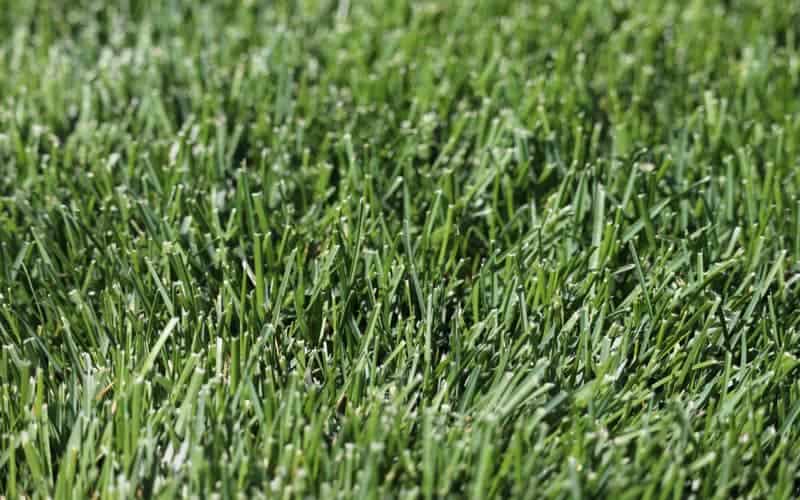
Growing conditions: Rich, well-draining soil; full sun to part shade
Watering: Frequent deep watering
Mowing: Once a week
Kentucky Bluegrass is a beautiful lawn grass, with fine leaf blades that sometimes appear bluish-green.
This cool-season variety is easy to recognise, as the tip of the blades is shaped like the prow of a boat.
Once established, it handles foot traffic better than most cool-season grasses.
Its roots also spread underground, which means it can grow back in bare patches.
However, Kentucky bluegrass doesn’t perform well in deep shade. Full sun or partial shade is ideal.
It also needs more care, including frequent watering and weekly mowing.
Kentucky Bluegrass is often blended with Perennial Ryegrass to help it germinate faster.
It’s also mixed with Tall Fescue grass seeds for better drought tolerance.
Perennial Ryegrass
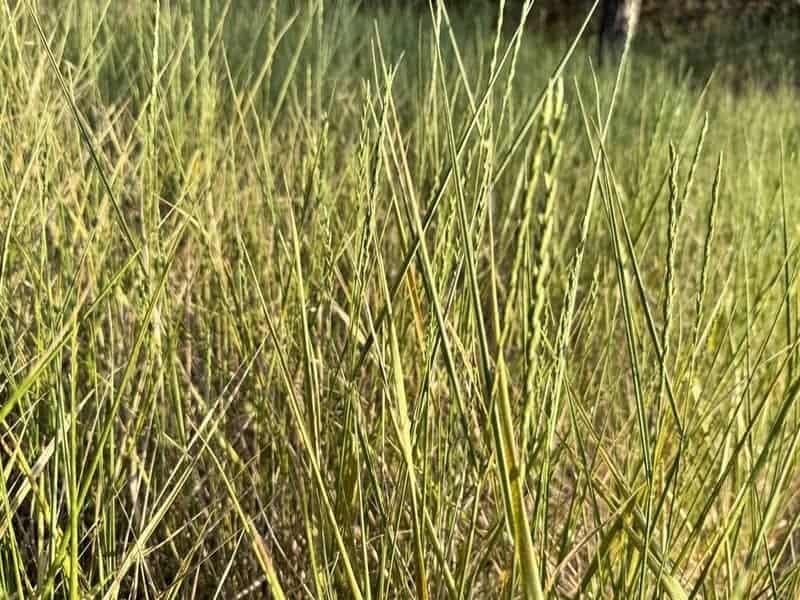
Growing conditions: Rich, well-draining soil; full sun
Watering: Frequent deep watering
Mowing: 1–2 times a week
Perennial Ryegrass is a fast-growing cool-season grass with fine, narrow, and shiny blades. It’s perfect if you want quick turf cover!
This grass also copes well with wear and foot traffic.
While it doesn’t spread like Couch or Buffalo, it can recover from damage by producing new shoots from the base.
That said, you might still need to overseed large, bare spots.
Also, be prepared for more upkeep. Perennial Ryegrass needs frequent mowing (1–2 times a week), along with regular watering and fertilising.
While commonly used as a standalone turf, Perennial Ryegrass is also used as a companion grass.
Many overseed it onto warm-season grasses to keep the lawn green through winter.
You’ll also find it blended with slow growers like Kentucky Bluegrass and Tall Fescue.
Tall Fescue

Growing conditions: Well-draining soil; full sun to part shade
Watering: Infrequent, deep watering
Mowing: Every 5–7 days
Tall Fescue is one of the best turf grasses for colder parts of Australia, like TAS and VIC.
Aside from being frost-tolerant, it can also handle dry spells.
This grass also performs well in deep shade, so it’s a good choice for areas beneath large trees.
However, Tall Fescue needs more care early on as it takes a bit longer to establish.
Also, keep in mind that many Tall Fescue varieties grow in clumps. They don’t spread, so they won’t fill in bare areas on their own.
That means you’ll have to overseed your lawn regularly to keep it looking full and healthy.
Another option is to choose the Rhizomatous (RTF) variety, which was bred to self-repair and grow back in patchy areas.
Other popular Tall Fescue varieties (not self-repairing) are:
- Lagertha: Resists pests and disease better
- Fortune: Bred in Australia to improve heat tolerance
- Currawong II: Low-growing; has glossy, dark green leaf blades
Tips for Maintaining a Healthy Lawn
Creating a lush, beautiful lawn doesn’t stop at choosing the right grass! Proper maintenance is just as important.
To keep your garden neat, make sure to mow regularly and at the right height.
It’s worth booking a professional lawn mowing service if you have a huge space or just don’t have the time for garden upkeep.
Also, be sure to remove weeds regularly, since they can compete with your grass for nutrients, light, and water.
If some areas seem to die off, fix bare patches to keep your yard looking dense and full.
Dead grass can also accumulate, so don’t forget to dethatch the lawn as needed.
Regularly top dressing the lawn with an appropriate soil mix or organic matter can also keep it healthy.
And if large or multiple sections start looking brown and unhealthy, don’t give up just yet.
There are ways to revive dead grass and restore your landscape’s vibrancy!
FAQs About Lawn Types in Australia
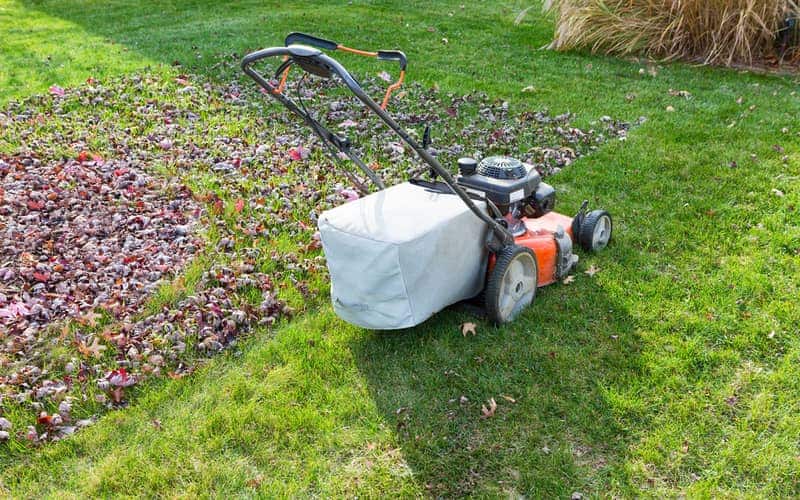
Still weighing your lawn options? These Q&As can help you choose the right grass!
What is the most popular grass for lawns in Australia?
Buffalo (especially the soft-leaf varieties) and Couch are two of the most popular lawn grasses in Australia.
They’re well-loved for being low-maintenance and drought-tolerant.
Zoysia is also a popular choice, particularly in coastal areas.
What is the best variety of lawn grass in Australia?
The best grass for your lawn in Australia all comes down to your local climate and how you use your space.
Buffalo is a popular all-rounder. It’s low-maintenance and handles drought, shade, and wear well.
Couch has similar qualities, but it looks finer and neater than Buffalo.
In coastal areas, Zoysia grass is a great option.
If you’re after a quick cover, Kikuyu is ideal. Just be prepared to mow often if you don’t want it to invade other parts of your garden!
For colder parts of the country, Tall Fescue (particularly the rhizomatous type) is often considered the top choice.
Which grass is best for my location?
Here’s a guide to help you choose the best grass for where you live in Australia:
| ZONES | LOCATIONS | RECOMMENDED GRASSES |
|---|---|---|
| Tropical and Subtropical | Brisbane (and the rest of QLD), NT, Northern NSW | Buffalo, Couch, Zoysia |
| Coastal | Coastal QLD, NSW, WA | Zoysia (and other warm-season types) |
| Temperate | Adelaide, Newcastle, Perth, Sydney | Buffalo, Couch, Zoysia |
| Cold and Cold Temperate | Canberra, Melbourne, Hobart, parts of NSW and VIC | Tall Fescue, or a mix of warm- and cool-season lawns |
How to identify your lawn grass type in Australia
To tell what grass you have, look closely at the leaf blades. Check the width, shape, and texture.
Also, observe how the turf grows. Does it spread out (like Buffalo, Couch, Kikuyu, or Zoysia), or does it grow in clumps (like Tall Fescue)?
Another factor is your local climate. Warm-season grasses thrive in most of Australia. However, you might have a cool-season type if you’re in a colder area.
If you’re still not sure, take a photo or a sample to a local grower or turf supplier — they’ll know how to identify your grass.
Knowing your lawn type is important so you can care for it properly!

